Was the Olympic Flame Once Extinguished and Then Re-Lit With a Cigarette Lighter?
Here is the latest in a series of examinations into urban legends about the Olympics and Olympians and whether they are true or false. Click here to view an archive of the Olympic urban legends featured so far.
OLYMPIC URBAN LEGEND: A cigarette lighter was once used to re-light the extinguished Olympic Flame.
While the interlocking rings that make up the Olympic flag are undoubtedly the most recognizable symbol of the Olympic Games, the Olympic Flame is certainly a close second. Representing the theft of fire from the Greek Gods by Prometheus, a fire was kept burning throughout the ancient Olympic Games. This tradition continues today, with a relay of the flame (typically via torch) from Olympia, Greece (home of the original Olympics) to wherever the current Games are being held.
The handling of the Olympic Flame almost always goes off without a hitch. In 1976, however, at the Olympic Games in Montreal, Canada, there was one notable slip that was magnified by the well-meaning efforts of a quick-thinking plumber with a cigarette lighter.
Like many other parts of the Olympics, as the years go by, the Olympic torch relay has gotten more and more elaborate. In the early days of the relay, the torch would be taken to the country where the games were being held and then the actual relay would begin. However, in recent years, more elaborate relays have taken place, likely set off by the 2004 Olympic Games, which were held in Athens, Greece. Since just taking the Flame from Olympia to Athens would not be particularly notable, it was determined instead to have the first global torch relay. A 78 day journey began, with the Olympic flame covering a distance of over 78,000 kilometers with over 11,3000 torchbearers. The relay passed through Africa and South America for the first time, and all previous Olympic cities were visited before returning to Athens to start the 2004 Summer Games. That approach has been used since then.
In 1976, the flame was delivered from Greece to Canada through a particularly novel means of transportation. The Olympic Flame was lit through normal means and taken to Athens, where an electronic pulse derived from the flame was then transmitted via satellite from Athens to Ottawa, where this pulse arrived and was used to set off a laser beam that made a flame. This flame was then taken by hand from Ottawa to Montreal. After the early days where who lit the flame was not a big deal, it has become increasingly important to pick the “right” person to light the Olympic Cauldron where the flame will remain visible to the public throughout the Games (that is actually part of the rules – the flame must always remain visible, which was a problem in the 2010 Winter Games in Vancouver, when the main stadium where the opening ceremonies were held, BC Place Stadium, was domed, so the Cauldron had to go in a nearby stadium where it would theoretically be visible even when the stadium was closed). The first celebrity to light the Olympic Flame was in 1952, during the Summer Games in Helsinki, Finland. Nine-time Olympic Gold Medalist Paavo Nurmi was given the honor of being the last person in the relay and the famed Olympic runner (who also won three Silver Medals) lit the Olympic Cauldron. In 1976, the lighters were two teenagers, Stéphane Préfontaine and Sandra Henderson, who were track and field athletes, one from “English Canada” and one from “French Canada,” to symbolize the unity between the two parts of Canada.

When the Flame is being transported, there are always backup torches lit from the same source. This is in case of accidental dousing. This way, a backup torch can be used so that the Flame still comes from the same Olympia source. In 2008, during their massive multi-continental torch relay, anti-Chinese protesters gathered at various points of the relay. In Paris, France and London, England, protesters (upset with China’s treatment of Tibet) tried to extinguish the flame repeatedly. The torch with the flame was carried in a high-tech aluminium device designed to withstand high winds and sabotage with fire extinguishers, but eventually the folks in charge of the relay decided it best to extinguish the flame and pick it back up later on in the journey (they actually had to extinguish it again later for the same reasons). However, since they had the backup flames, it was not a big deal.
In 1976, though, an unexpected cloud burst doused the flame at Olympic Stadium. The problem was that no one was around, because there were no games scheduled that day. The only people on scene were workmen. One of the men, a plumber named M. Pierre Bouchard, quickly rushed up the steps of the platform holding the Cauldron and used a cigarette lighter to light some pieces of newspaper, then used his ingenious little contraption to re-light the cauldron. Naturally, when Olympic officials were notified of the situation, they quickly rushed over and extinguished Bouchard’s make-shift Olympic Flame and used the backup torches to re-light the Flame.
While it is pretty humorous, it was also quite enterprising on Bouchard’s part!
The legend is…
STATUS: True
Feel free (heck, I implore you!) to write in with your suggestions for future installments! My e-mail address is bcronin@legendsrevealed.com.







While Paavo Nurmi’s three silver medals are impressive for most athletes, I’d say the nine GOLD medals he won were even more impressive. Two of those he won on the same day during the 1924 Olympics in Paris, winning both the 1500 meters and 5000 meters in Olympic record time.
True, but that’s why I mentioned the Gold Medal the first thing in the sentence. 🙂 The Silver Medals got an “also.”